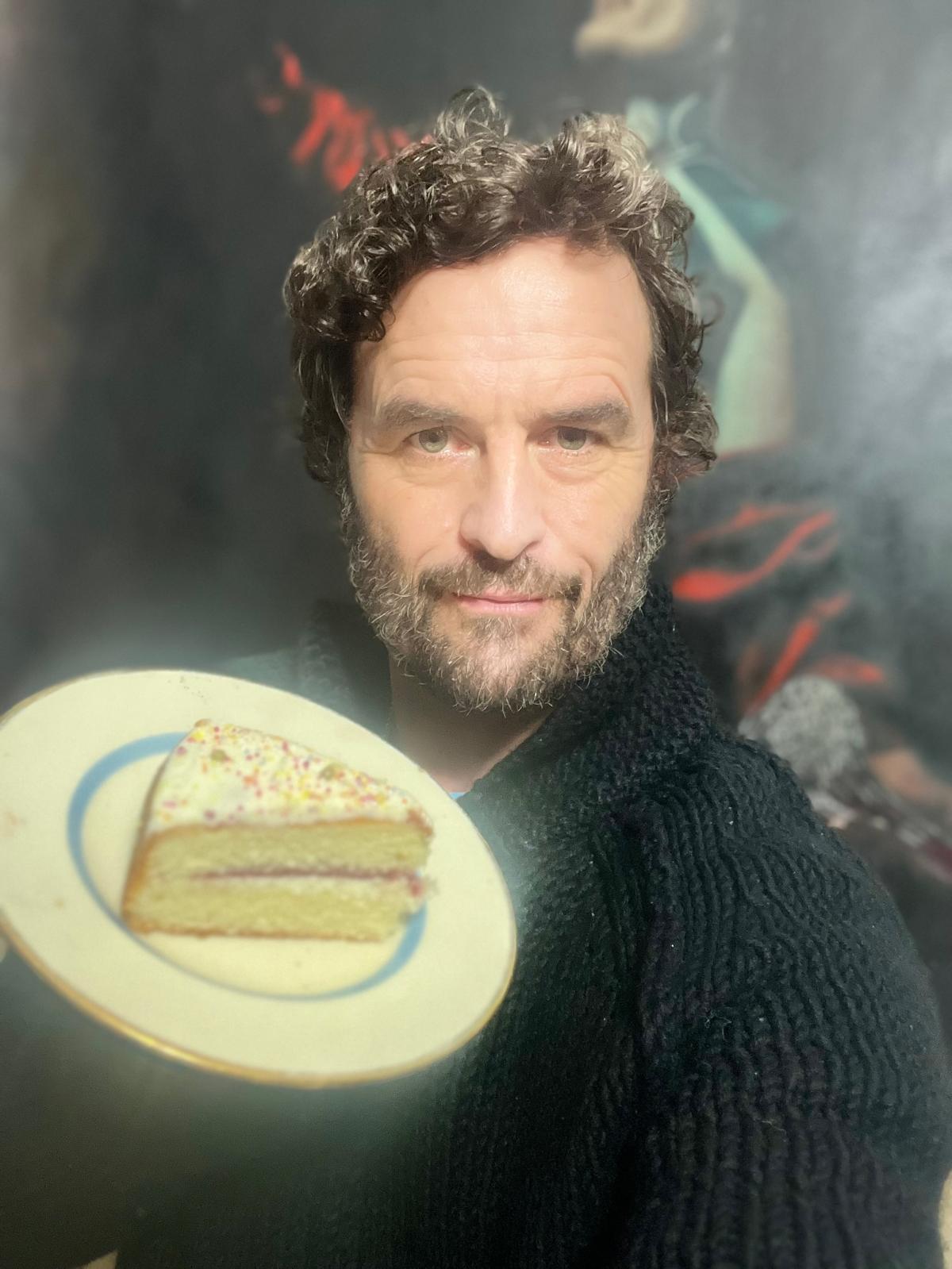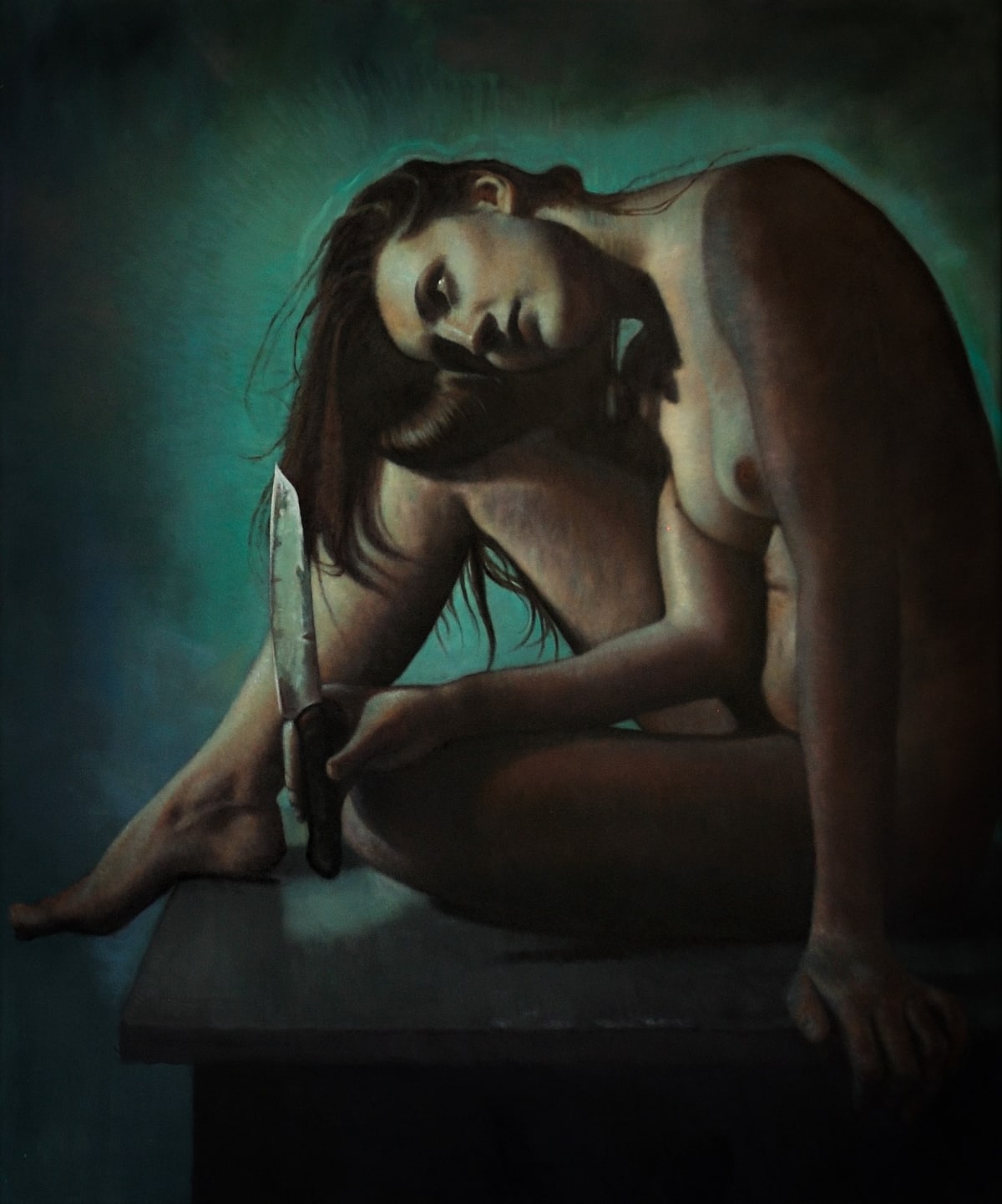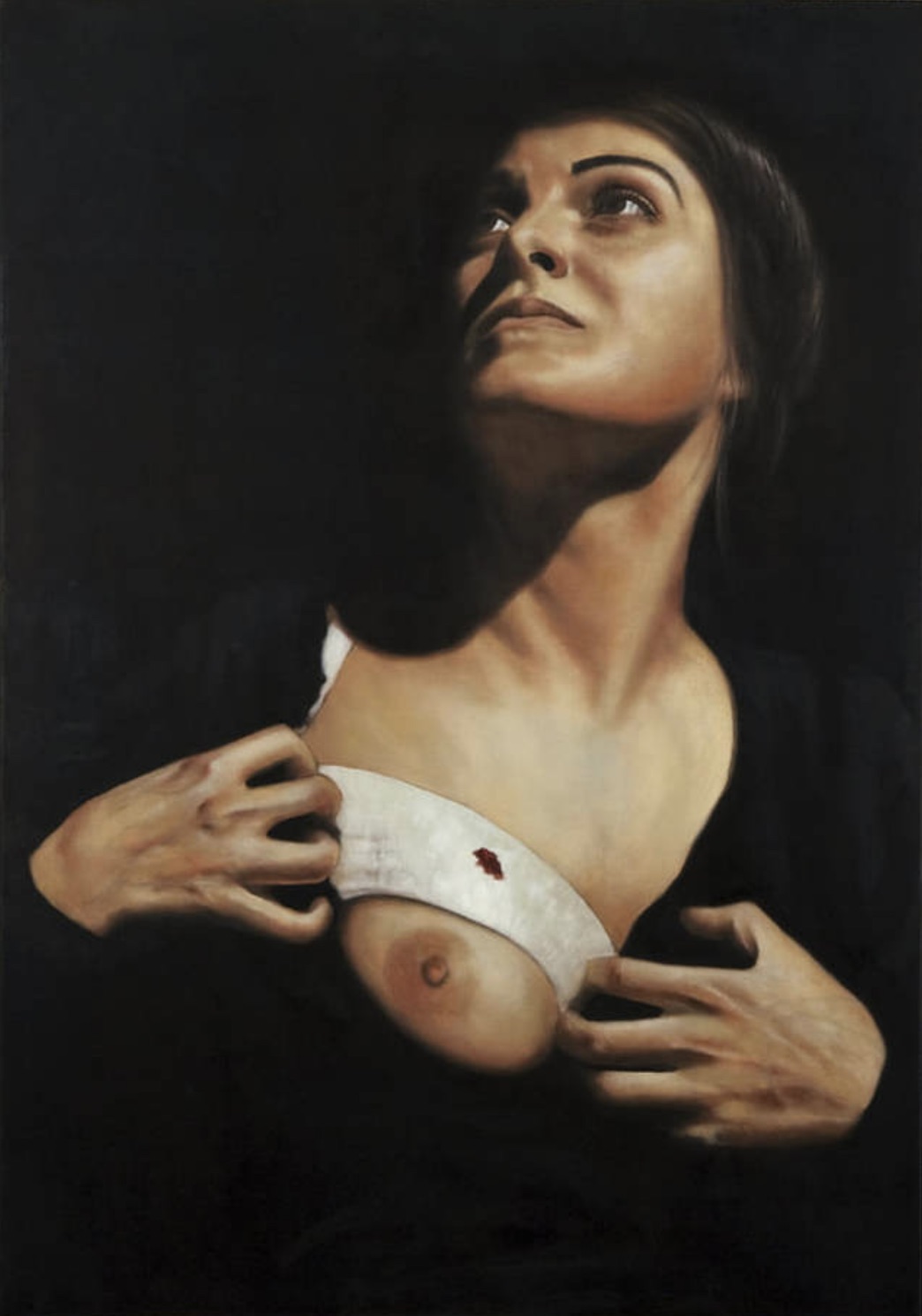Mark Metcalfe

There is a darkly mystifying and hyper-realism, captivating the underlying expressionism in Mark’s paintings, exploring his work further I discovered more lucid layers in his character studies and historical mythical analyses, traversing a modern playground of life. His life-like paintings appear to be investigating and defining multiple genres, touring the archetypes of femininity, historical fiction and contemporary ideology with symbolic clues and secrets. The portraits, of individuals he knows and also more poignantly self portraits are painted with a realism, however, they convey the clues and breath of progressive thinking with parallels to literature, history and fables and sometimes all coexisting together in one painting. You have the same wonder and awe as you stare at the grand and ambitious in extravagant compositions, that are psychologically layered and resolutely enigmatic. He summons the idea of the facade he gives an example “The white noise of social media” then playfully pushes forward for us to detect the hidden myths and allegories. Painted with a photo realistic technique, a specific style of painting, it’s very labour extensive and there are no brush strokes, and often painted with a palette of dark and atmospheric tones adding to the faintly directed surrealism that he engages in symbolic scenarios.




I was introduced to Mark when I went to see his work at the JD Malat Gallery in Mayfair, and was excited to meet again and talk in depth. He is currently renting a cottage on the Essex Coast and renting out his studio on the Thames barrier in London. Originally from West Yorkshire, his place of birth Thornton, the home of the Bronte sisters, Metcalfe describes his life growing up in the rural countryside, his father was earning a living as an engineer but he was also an artist, he describes his father as a Sunday painter. Mark describes getting up for school and seeing his Dad’s easel, who painted landscapes, “Dad would work long hours, getting up every morning at 5 am to paint.” Mark talks about the influence this had on him, he describes his parents as hard-working, working class. He remembers that he was always good at art, “I had a facility for it” he tells me. He did do art O-levels, and then intuitively went into mechanical engineering, it was expected of him he explains. However, he was always painting for himself and at the age of around 27, he moved to Wellington Somerset, he tells me about a day when he was outside painting a landscape of a waterfall, when a man saw his painting, gave him his card. It was not long before the man, who owned a gallery, held an exhibition of Mark’s landscapes, and all his artworks sold out. This was the beginning of his career as an artist full-time.



Metcalfe went on to study with first-class honours in a BA in Fine Art at the London Metropolitan University and followed with an MA at the University of the Arts, Camberwell London. He additionally spent 10 years working as an assistant to Damian Hirst, describing the pressure and how you have to be on your A game when working for him. “Whatever the man touches turns to gold” he is a very busy man. Emphasising the skills to learn that were taught to him “As well as tutors” it’s a very busy environment, quick fast, and he has worked closely with Hirst. He was hired to assist with fact painting, he describes the essentials with the skills involved and how the paintings are hyper-realistic. These skills as an assistant along with the tuturials at university that were more anti-painting in contrast “Goldsmiths pumped concept art into me” he explains “It was all more about ideas with them, instructions and set” he explains how there is no tutoring. “The goalposts are constantly moved, it puts you in a state of panic,” he tells me. For the interests of critical theory, much of his work stems from literature. He describes himself as a voracious reader of books and poetry.



His figurative work came about looking at the greats, Goya, Victor Man, Katie Heck and Freud and “Many Romanian painters, the old masters and contemporary masters and Faust” he describes how everything was epic, all of these things he looked at, and he wanted to encapsulate them into his paintings. He elucidates his style as figurative but with all sorts of cartoon emblems, and innuendos, inspired by the 80s when he was a boy, he recalls, the videos of the graphically painted VHS covers and how fascinated he was, and places innuendos of them into his work. His palette is quite muted, inspired by Japanese brush painting, “Their compositional traditions have three planes a foreground, a middle and a central figure, often connected by ethereal patches of mist.” Metcalfe explains. “It’s fauvism” all the things he found visually absorbing, things to try out and be epic and not look at trends references. He paints quite fast once he has an idea, and it is clear through our conversation, how he supports the narrative and makes a conscious choice and at the same time an unconscious choice.


He relates to Jung’s archetypes, in relation to Faust, finding movement through archetypal characters that references and alludes to fallen characters ‘Verfallenheit’. He feels it is a great premise for a painter. Sometimes he uses biblical scenes, he is currently engaging with the Book of Enoch, he paints the fallen angels, with a modern twist wearing Adidas and a boiler suit, he shows me a figurative painting of an American lady that he is working on, which is also part of his Fallen Angel series. His current exhibition at the JD Malat Gallery, are extension of the Jungian archetype, he gives an example, Goya’s relationship with the Duchess of Alba, “The connotations of fantasy, transaction of painter and muse and the sacred feminine. Each canvas represents an element, fire, air, water, earth, spirit,” he explains, each one has its own and then he adds things like tarot cards, he wanted to put something esoteric into it, “it is all about the hands”. It’s these seeds of ideas that he translates into his paintings that hold the whimsical, into narration. The narrative is important to him, very important he emphasises, he will have a core of an idea, he gives me an example. He works with photography and models, with that foundation, that as he is painting a sort of a visual conjuration occurs, as he engages a certain part of himself, that you didn’t think was there.



We chat about which artists inspire him, he lists his favourites Kati Heck, Victor Man, Nicola Samori, Maggi Hambling, Velasquez, Bacon and de Kooning. We talk about his myths, “Every painter should have a personal mythology, as an antidote to concrete brutalism” he gives an example, describing the dim architecture of the 60 and 70’s. “Hambling is a wonderful example of the ‘Personal Mythology’ of a cigar smoking Jaguar driving painter, completely at ease in her own skin as a painter” he tells me. “A remarkable being she is, and she went to Camberwell” he tells me. “Whenever I doubt the point of my practice I watch her interviews” he explains. “Followed by ‘The Rebel’ with Tony Hancock, a film all art students should see on the first day of art school”.

I asked him how he felt his upbringing impacted his art, Mark explains that even though he grew up in rural Yorkshire, he was mercurial to the idea to get out of his town, describing how he has always had a sort of gypsy soul, a bit of a roamer, painting was partly upsetting the apple cart, his parents didn’t want him go into the arts. I asked Mark what his ambitions were “Keep making solid work, and push with motives”.


Metcalfe has had many shows, his ideas are very avant guard and he has won many awards, including the European art award, he is also a printmaker, working with Lithography and etching, although painting is his greater love, he paints quickly, very large paintings up to 2 meter canvases, it usually takes him about three weeks to paint a painting. I asked him what he considers his greatest achievement so far, “I guess the pinnacle of my career has been the luxury of being able to paint my own work after a long spell of working for other artists” he tells me “To let the unconscious kind of play itself out and unravel, however it may”. Having his work at a decent gallery. Then we talk about what is perfection, Mark describes how he considers perfection a loaded multifaceted thing. He tells me about how he enjoys yoga and refers to the attempt to get into a full lotus and that the attempt, with all its cramping and discomfort, is ‘Buddha realised’ and he adds “There is no cure, no end goal. We are in the process always.”

We finished when I asked him If he could own any work of art, what it would be, and he revealed to me, that it would be the Las Meninas by Diego Velazquez.
Interview: Antoinette Haselhorst
